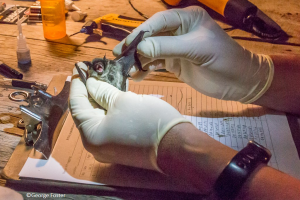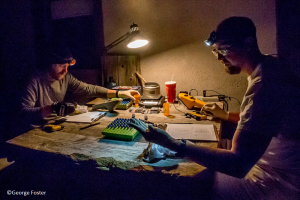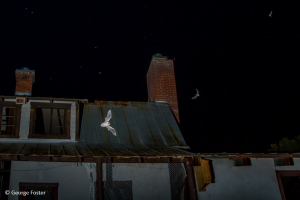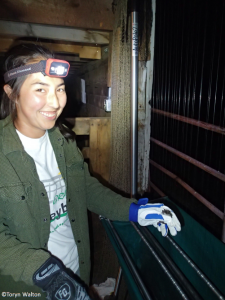North American bats have been experiencing unprecedented declines because of a novel disease called white-nose syndrome, wind energy conflicts, and likely because of declines in their insect prey. White-nose syndrome is a disease caused by a cold-loving fungus, and when hibernating bats are infected the fungus shows itself as a white fuzz on the muzzle, ears, and face of bats. When the disease hit eastern bat populations the evidence was clear, as hundreds of dead bats were found at the openings of caves that used to be home to thousands and millions of bats. In western North America, understanding when such a disease hits will be more challenging because many winter roosts house much fewer bats. For example, in Colorado, the largest winter colony of bats is approximately 600.
Because of a lack of large winter colonies, Colorado Natural Heritage Program zoologists Rob Schorr and Jeremy Siemers are turning their attention to monitoring summer colonies. Since 2014, Schorr and Siemers have been conducting mark-recapture studies of little brown bat (Myotis lucifugus) maternity colonies in northwestern Colorado. They have inserted passive integrated transponder (PIT) tags in >1,000 bats, and rigged their roosts with PIT-tag reading antennas to record the arrivals and departures over the summer. These data are valuable for estimating survival of bats and understanding fidelity to roosts.
This year Schorr and Siemers recruited two ambitious Colorado State University undergraduate researchers, Kira Paik and Toryn Walton, to understand what other roosts little brown bats use. Paik and Walton spent the summer tracking 22 little brown bats that were fitted with small radio-transmitters. They discovered that the adult female bats, despite traveling over 30 miles on their evening feeding travels, tended to return each night to roosts that are within a couple miles of the main maternity colony. This knowledge is extremely valuable for understanding where additional mark-recapture effort should be directed if biologists want to identify bat population trends.
 |
| Little brown bats after being tagged. |
 |
| Siemers & Schorr marking little brown bats. |
 |
| Little brown bats flying around one of the maternity roosts. |
 |
| Paik & Walton with the field vehicle for tracking telemetered bats. |
 |
| Paik at the harp trap with a captured bat. |
 |
| Walton tracking one of the telemetered bats. |




